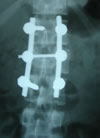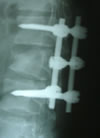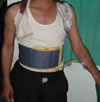Spinal trauma is common following road traffic accidents and fall from heights. With a great deal of force vertically onto the spine, a vertebra may be crushed. If it is only crushed in the front part of the spine, it becomes wedge shaped and is called a compression fracture. However, if the vertebral body is crushed in all directions it is called a burst fracture. If the force is also accompanied with forward bending the posterior part of spine gets distracted. This is termed as flexion-distraction injury. In severe injuries accompanied with shear the spine may also dislocate.
The bony fragment that spread out toward the spinal cord can bruise the spinal cord causing paralysis or partial neurological injury.
The assessment of injury is done with X-rays, CT Scan and MRI. Once the patient’s condition is stabilised, judgment is made whether a fracture is stable or unstable. Stable fractures are treated with spinal braces. Unstable spine injuries are fixed either from anterior, posterior or combined approach. In posterior surgery pedicular screws are used to reduce the fracture. In anterior surgery the vertebra is removed and the defect is filled with either an artificial cage or bone graft.Patients with paraplegia require aggressive rehabilitation. They may develop complications such as chest infection, urinary tract infection, bed sores and soft tissue contractures. Stem cell therapy may offer a breakthrough in treatment of these patients in future



